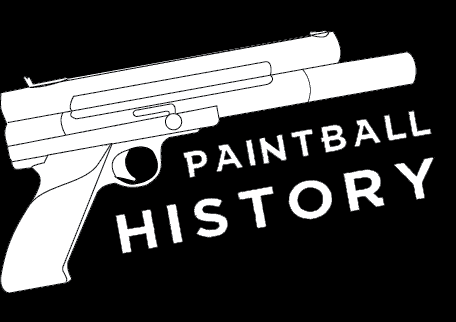Back in November of 2014, Simon Gascoigne, out of Yorkshire, UK, emailed me with a few photos and questions about a unique Lapco Grey Ghost he acquired.

Simon writes:
“I was told [it] is an early original LAPCO Grey Ghost, possibly even a ‘one off’ / prototype according to the guy I bought it from.”
Usually when I hear “one off” or “prototype” concerning paintguns from the late 80s and early 90s I’m skeptical. Many paintballers might see a pvc pump handle on an old Line SI Skirmish or a direct feed, soldered on a Sheridan PMI 68 Magnum and think these were prototype modifications that add value. In some cases these (Skirmish) these are earlier versions of a mass produced items and in other cases (PMI 68 Magnum) after market accessories have been added. But there are also many innovations during their period of paintball’s history, so I cross my fingers and hope for something unique.

But since Simon’s questions centered around one of Colin Thompson products, there was a pretty good chance the the items is unique in some aspect.

Many of Colin’s guns had custom features which are unique to the period he built the paintgun (specific month in most cases before 1991) and those pieces in many cases could be consider prototype parts. Thompson was constantly refining parts and tinkering with different ideas to improve his guns.
This is why there are so many different Lapco hammer designs, produced in stainless and brass. And in these two materials, Colin made Nelson hammers in light, medium, heavy and full uncut (maximum weight) and he even engraved some of the flutted cut down hammers (for looks) with LAPCO.

Simon explained that this Lapco Ghost came from a friend at a local market who mentioned “that this was a bespoke and rare marker and that the barrel may be an unusual length ([16]”inch).”

This very elaborately accessorized Ghost does have many unique features and uses a very early Lapco/Wintec frame model which would likely put it around late 1989 or very early 1990. This frame and the pump arm’s edge likely provide the best indicators on this Ghost’s date of production.

After helping David Bassman (Colin’s Dungeons and Dragons Dungeon Master) keep up his fleet of rental Nelspot 007s at Conquest in Malibu, California, Colin began fabricating his own pieces to fix issues.
He eventually assembled his complete “Colin Gun” pump in 1988 with the standard Nelspot 007 frame. He then moved to the Carter/Tri Jay/NW frame in late 1988-89 and produced a batch of his guns with this set up.

After the “Carter style” frame he briefly used the transitional WGP frame which was milled aluminum and could be match anodized. WGP didn’t produce this style frame for long though, and Colin ended up only making a few Ghosts that used this receiver. This model of Ghost is one of the most difficult to track down (aside from a Daystar). The WGP transitional receiver was likely only used in the beginning of 1989 by WGP for the late model Commando and the Late model Sniper 1 (and 62 cal sniper).

After briefly using WGP’s “transitional frame,” Colin contracted (?) Wintec to build his Lapco/Wintec receiver. In the March 1991 issue of Paintcheck, Ken Kelsch describes the timeline of Colin’s wedge sliding trigger Lapco/Wintec receiver.

In the March of 1991 issue of Paintcheck magazine, Ken Kelsch wrote up an in depth article on Colin Thompson titled, “The History of Lapco.”
Kelsch covered Colin’s progression from starting out helping David Bassman at Conquest, to Colin alluding towards Lapco’s developments yet to come.
Kelsch accurately dates the first production of the slide trigger frame to October of 1989 and writes:
“Once things had settled in for a while, Thompson decided to disrupt his manufacturing processes by changing the Ghost again.”

Explaining Colin’s new design for a trigger, Kelsch continues the article:
“His new aim was to replace the Carter-style lower receiver with one that had a “straight back pull trigger” and could actually wedge the sear straight up like an elevator rather than tilt it up like a seesaw (control must be absolute around here obviously). Of course, everything in the trigger had to be adjustable to include trigger travel, creep and pull, and the auto trigger had to be adjusted to critical breaking point preventing unacceptable velocity drop. Grey Ghost owners with guns made after October ’89 can attest to the success of this concept.”

Ken goes on:
“Solid ergonomic handles made their debut in January ’90 with a wide variety of plastic (black or camo) and wooden grips. My personal favorite development of last winter was the Bottom Line.
Although I like the skeletonized Stan Russell stock on my Ghost, I immediately saw the advantage of running my hose directly from the bottom of the hand grip and using the 7 oz bottle as the shoulder stock. The Bottom Line helps to insure that CO2 is delivered in its gaseous form.”
The selection above is only one portion of Kelsch’s three page article. Find the scans of this interesting read on Tom Boyer’s Old Paintball Magazines at:
Page 1: https://www.facebook.com/oldpaintballmagazines/photos/1396750663920605
Page 2: https://www.facebook.com/oldpaintballmagazines/photos/1396750603920611
Page 3: https://www.facebook.com/oldpaintballmagazines/photos/1396750697253935
And the album of the photos scanned from the March 1991 Paintcheck at: https://www.facebook.com/media/set/?set=a.1396749953920676.1073741902.1392059741056364

From Kelsch’s article I would assume that Colin had his first run/batch of his frames using the M-16 lone star mount made in October 1989 by Wintec which he used on his Ghosts. After this initial run Thompson likely decided it would be simpler and more aesthetically pleasing to design a grip he could directly mount his newly developed bottomline to without several additional pieces of hardware.
It’s also a possibility that Wintec, with the tooling set up to produce a large number of the Lone Star frames, decided to continue producing the m-16 frame version or had possibly already run a large number of the frames, ready for Colin’s next order.
And with Colin changing his design, possibly Wintec was stuck with these frame. This could have led to the production of Wintec’s own pumps, which mostly used the Wintec m-16 frame, and the frames being used on Steve Buzick’s Reblines, as well as AGS pumps (after the Taso/AGS split).

But one thing is for sure, the majority of Colin’s top tier guns from this point forward used his one piece grip design. Colin (and Lapco) continued to use the M-16 version of the Lapco/Wintec frame on rental versions of his markers (such as Wraiths, Vamps and Specters) but the majority of Colin’s pumps used the full frame.
Before serializing some of the Lapco/Wintec framed Ghosts, Colin engraved a few with production/build dates.
Rob “L.I. Caretaker” Navas writes, on mcb, about his Lone Star receiver Ghost that has the date engraved and came from a Werewolf’s player.
Navas writes:
“Hand engraved on Bottom. 11-1-1989 .689 Grey Ghost
This was 1 of 30 made for the WEREWOLVES OF N.J.”
Find Navas’ post in the link below from February 28th, 2011:
http://www.mcarterbrown.com/forums/pump-markers/152797-ghost.html
Navas’ ghost is an excellent indicator on the date Colin was transitioning to the Wintec frame from the Carter frame and goes along perfectly with Ken Kelsch’s timeline in the quote from the March 1991 Paintcheck.

The Wintec receiver on Simon’s early Ghost is a 1989 Lapco/Wintec M-16 frame with a Sheridan UMB (Universal mounting bracket) style mount attached. The photo above is one of the only other examples I’ve seen of this Lapco setup, which was on ebay back in 2004.

I think Stan Russell may have made this set up with Colin since Russell’s UMB mounts used side screw in plates (see photos above). Or Colin could have built it himself since he would occasionally work on projects out of Stan’s shop in Los Angeles at that time.

The stock is likely one that Colin made at Stan Russell’s shop and has some additional extra milling on it. The tank cage is one of Stan Russell’s and are uncommon with that milling.

Above is a photo of a Termite with the same tank cage. The stock is essentially the same as well but Colin’s stock may have had different milling in some cases.

The camo grips on Simon’s Ghost are also Unique. Colin explained to me that Rick West designed his moulded grips in Black and Camo. Describing his own photo, pictured above, Colin wrote me that, “The blond haired guy in sunglasses is Rick West. He made the plastic grips.”
I’m not exactly sure which of the two pictured is West, one is man blonde and the other is wearing Sunglasses?

Colin also explains how West created the Camo Lapco grips, “He had to paint the inside of the molds by hand for those.”
Simon write’s me that “The grip is camo [and not painted]” so as Colin wrote me, the paint must have been inside the mold and fused with the plastic used making the original paint part of the molded grip panel’s plastic.

Other neat details on this Ghost, such as the engraving on the pump arm and receiver rail, help to corroborate the early date of late 1989. The end of the pump arm is also square and not round. The earlier Ghost arm ends were round and Colin eventually in 1991 transitioned to square ends.

The adjustable riser sight on this Ghost is another neat Lapco piece which occasionally shows up on Colin’s gun or can be found separately on misc 1 inch OD nelsons.

All the unique additions, light rail engravings and neat stock/frame set up make this a very unique and historical Lapco Ghost to place in Colin’s timeline of masterpieces. And with a little work replacing the blemished / non specific pieces to this gun it could be once again rocking on the field and a shining show piece at home.
Thanks to Simon Gascoigne for sending the photos of this early Lapco Ghost! And giant thanks to Colin (RIP) for his willingness to help and the permission to use his photos.
Find a video with Colin at:
https://paintballhistory.com/colin-thompson-invention-bottomline-asa
And find more LA Paintball Company paintball articles at:
https://paintballhistory.com/tag/lapco








All credit to Dan Bacci for his kind, meticulous and thorough review of my Grey Ghost.
Thank You Dan
All The Very Best
Simon Gascoigne
RIP Colin Thompson (genius)